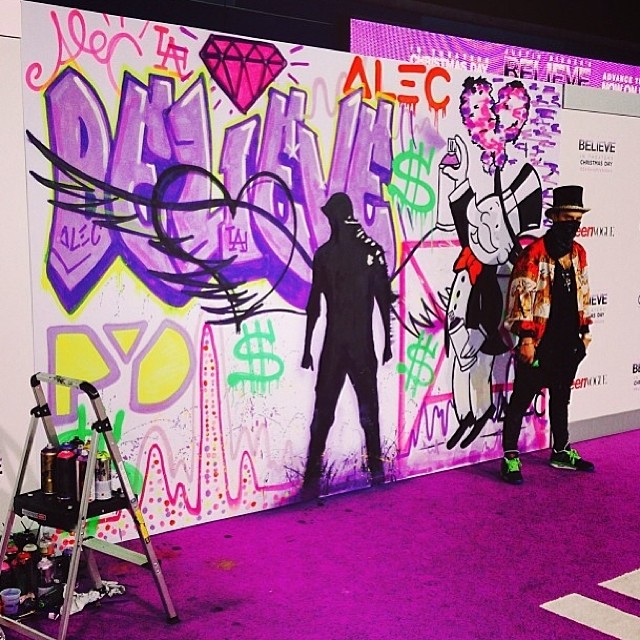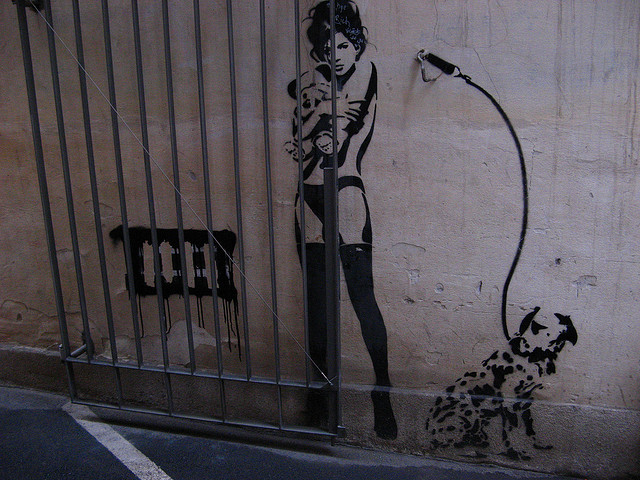
With the advent of street art as a post graffiti movement, the infiltration of a visual style highly influenced by the fashion industry’s mode of exploitation has taken a hold of an otherwise fertile art movement.
In the early days of graffiti, the visual aesthetic was dominated by a font-based style. This style developed over the course of the first two decades into a scripted freehand-based art form that was recognizable for its lack of outside influence.
By the 2000s, with the rise of the popularity of stencil art, the influence of a visual aesthetic informed by the post-pop movement came to dominate the graffiti and street art scenes. The ease with which an iconic image could be duplicated into a stencil using printers accelerated the spread of street art as a popular art movement.
Yet the narrative of this movement has become increasingly dominated by certain visual techniques, relying on fashion industry imagery to create popularly accessible art that is seen by a wider and more demographically homogenous mainstream audience.
Even a short trip down to any popular “street art gallery” will make the viewer immediately aware of the fashion industry’s overwhelming influence on this nascent art movement. Endless reproduction of women’s bodies and faces, superficially disassociated from their fashion industry roots, has permeated the creation of street art. Images of women in particular have come to be shorthand for catchy, iconic statements. Movie stars, music icons, and models all find themselves endlessly repeated, stenciled and pasted onto shops and walls; instagrammed out into the world, becoming a viral reinforcement of the level of popularity found in recreating a photographer’s work (often without credit). Subsequently pushed onto canvases in order to monetize the popularity of the work, this imagery continually recycles itself into an endless objectification of the female.
Graffiti and street art have long been male dominated practices. Despite the recent “Women on the Walls” program in Miami and other female-centered group shows and mural festivals around the world, there are still much fewer female artists working in the medium when compared to other visual art movements. This male dominance has created an intractable acceptance of exploitative female imagery, the selling of which only reinforces the desire in younger artists to utilize similar imagery within their work.
The image of the human face is something that feeds a very deeply rooted desire for pattern recognition in the mammalian mind. We see faces in even the most abstracted blots of colour, stains of water on walls, bits of burnt toast, dust on the windows of abandoned factories. The mind is wired to react to the recognition of the human face with a sense of pleasure. Once we see the face within some random abstraction, it is likely that we can never “unsee” this imagery as it was before.
As street art has gone mainstream, its popularity has birthed an industry that capitalizes on its pop culture status. Demographically targeted goods from custom graffiti paints to clothes have seen an enormous upswing in the past decade. Far from its modest origins as an illegal art form, street art more often finds itself sponsored by corporations looking to broaden their niche appeal and to cash in on the massively swollen “subculture” that it has given birth to. The culmination of this is the interaction between the fashion industry and the “hot” street artists willing to basically license their brand in order to cash in.
The fashion industry is without a doubt the most exploitative commercial industry on the earth. From the forced gender stereotypes and impossible to achieve body presentation of its models (invariably fictions created in photoshop) to the garment workers’ horrifying work conditions and third world wages, the fashion industry reeks of the blatant disregard for both the welfare of its disposable minions and the crass exploitation of its customers.

In order for street art to become a truly groundbreaking and self-aware art form, young artists of this generation need to recognize that the exploitation of women through sexualized and objectified imagery is merely a continuation of the corporate stranglehold over young people’s ideas of self worth, societal value and personal gender identity.
Streets artists working in this medium need to take a deeper look at the content of their creations. Given some introspection and forethought, one comes to see that the use of fashion imagery is like a cancer spreading inside of a once independent subculture. Rotting away the core of its value by co-opting its aesthetic techniques in order to market products via the continual appropriation of youth culture that has so long fed the fashion industry. The truth is that these corporations have stolen and co-opted street art and are selling it back to young artists at a retail markup.
Just because that movie star’s face or that fashion model’s body gets an artist shares and likes on social media doesn’t make the work profound or valuable to the dialog of creative practice. We must free ourselves of this insidious institutionalization of objectification that has grown within the street art and graffiti communities and learn to support women in the arts, not just those that paint murals, but all women young and old.
Photos from Alec Monopoly’s Instagram and by a_kep
